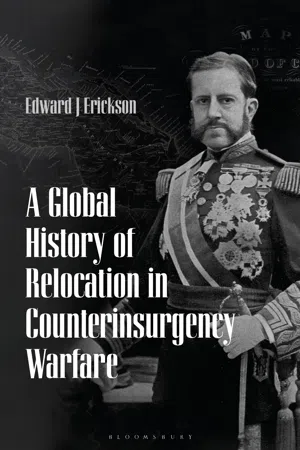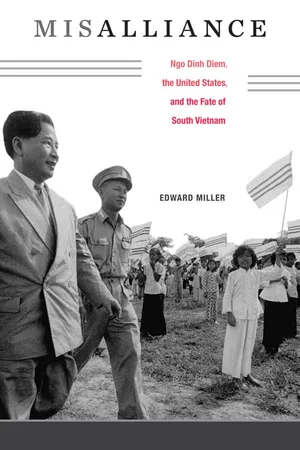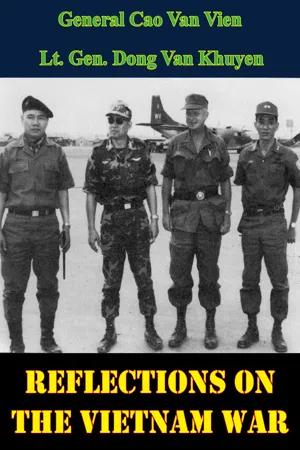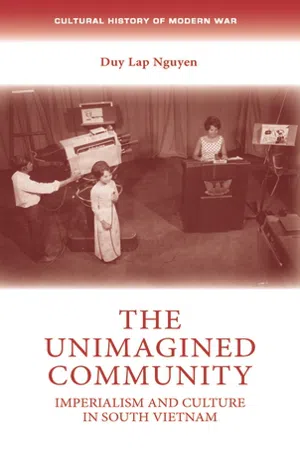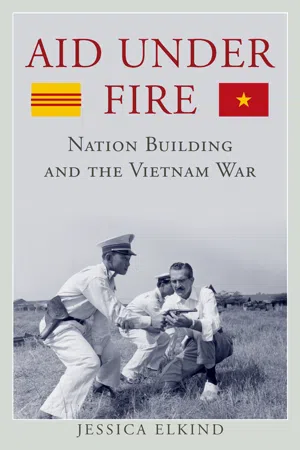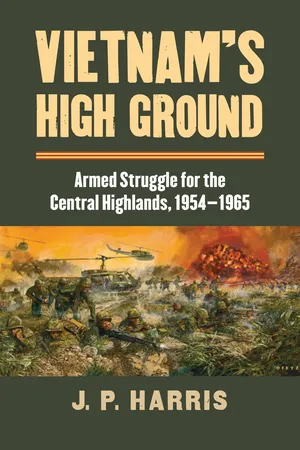History
Strategic Hamlet Program
The Strategic Hamlet Program was a counterinsurgency strategy implemented by the South Vietnamese government and supported by the United States during the Vietnam War. It aimed to isolate rural communities from Viet Cong influence by relocating villagers into fortified hamlets. The program faced significant resistance from the local population and ultimately failed to achieve its objectives.
Written by Perlego with AI-assistance
Related key terms
Related key terms
1 of 4
Related key terms
1 of 3
10 Key excerpts on "Strategic Hamlet Program"
- Edward J. Erickson, Edward J Erickson(Authors)
- 2019(Publication Date)
- Bloomsbury Academic(Publisher)
11 Counterinsurgency at the ‘rice roots’ level: South Vietnam’s Strategic Hamlet Campaign Dr Nathan R. PackardThis vast movement, born in the heat of war, is our pre-emptory reply to the Communist challenge. … The strategic hamlet is also and primarily the point of impact of a political and social revolution which will serve as a foundation of our economic revolution.PRESIDENT NGO DINH DIEM, 1962Introduction1From 1961 to 1963, the South Vietnamese government of President Ngo Dinh Diem, backed by the United States, implemented the Strategic Hamlet Program. The primary threat to South Vietnam was a communist insurgency known as the National Liberation Front (NLF) or Viet Cong (VC). In a country that was 88 per cent rural, with an estimated 2,500 villages divided into 16,000 self-sustaining hamlets, winning the war in the countryside was essential.2The communists considered the villages their centre of gravity and organizing at the village level had been the centrepiece of their strategy dating back to the colonial era. The Strategic Hamlet Program was one of the few strategies pursued by South Vietnamese and the Americans that directly challenged their adversary’s programme in the countryside. The intent was to separate the rural population from the insurgents by establishing protected hamlets. In addition to security, the government would hold free elections and provide economic aid, medical facilities and educational services. The ultimate objective was to build support for the government in the countryside thereby reducing the insurgents’ influence.Conceptually the programme called for building defences around existing hamlets. In practice, however, tens of thousands of villagers were forcibly relocated. In time, relocation came to define the programme. This chapter will examine whether or not the Strategic Hamlet Program achieved its military objective of pacifying the countryside by increasing support for the government at the village level. At best, the programme represented a comprehensive, whole-of-government effort to defeat the insurgency at the ‘rice roots’ level. Despite some initial successes, involuntary resettlement, forced labour and the failure of the government to deliver on its promises bred resentment. The programme ultimately failed to win over the populace and was cancelled following the overthrow of the Diem regime in late 1963.- Christopher K. Ives(Author)
- 2007(Publication Date)
- Routledge(Publisher)
Insurgent military formations reconstituted and formed new ones. Leaders in Saigon and Washington also saw the apparent insecurity of the strategic hamlets as the thin reed of Diemist assertions of success snapped in a steady breeze of Viet Cong/National Liberation Front subversion and clandestine political development. Despite a sustained military and offensive strategy, success proved elusive, helping bring about the coup that removed Diem in November 1963.Strategic hamlets
South Vietnamese efforts in village-based counterinsurgency like the Strategic Hamlet Program, though successful on paper, not only failed, but actually accelerated the crisis in rural South Vietnam. The Strategic Hamlet Program violated peasant trust, and created tensions with relocations and corvée labor for public works and defenses, as well as and providing more security problems. The program set as its goal ultimately to have 90 percent of rural South Vietnam’s population settled in government-fortified and developed hamlets. Interim objectives of this program included security from VC mobilization efforts, economic development, and political indoctrination through developing an awareness of democratic values. With a nod to indigenous programs tried in 1959, Saigon’s efforts mirrored British programs in Malaysia and followed the advice of Sir Robert Thompson, since 1962 the head of the British Advisory Mission in Saigon.Precedents
The Strategic Hamlet Program was the principal counterinsurgency element of the combined operations.2 Promulgated by a National Security Council Action Memorandum in August 1961, the program built, in theory, on the lessons learned from Diem’s less-than-successful agroville experiments.3 Agrovilles began in 1959 and ran into 1961 before their collapse. This program was an ambitious undertaking to concentrate rural populations for economic development and control. Joseph Zasloff, a former administrator with the Michigan State University advisory group, quoted President Diem’s words from a radio address that promised southern peasants that he would ‘‘create densely populated settlement areas in the countryside, where conditions are favorable to communication and sanitation and where minimum facilities for the grouping of the farmers living in isolation and destitution in the back country exist.’’ Based on relocation, corv´ee labor, and without any legitimate land reform, agrovilles were not well received or successful. Propaganda efforts by the Diem regime could not overcome the program’s shortcomings or the very real resentment felt by the peasants, who bore the weight of the labor, and the uncertainty, and then found themselves targeted by insurgent mobilization efforts with propaganda and more.4- eBook - ePub
- Edward Miller(Author)
- 2013(Publication Date)
- Harvard University Press(Publisher)
Like their RVN counterparts, U.S. officials in Saigon and Washington were often bewildered by Nhu’s monologues on the “triple revolution” and the rest of the ideological rationale behind the Strategic Hamlet Program. This did not mean, however, that the U.S. government was uninterested the palace’s proposals. On the contrary, the embassy and the Kennedy administration viewed the emergence of the program during late 1961 and early 1962 as a highly encouraging turn of events. Although they had not been involved in the program’s genesis, U.S. officials and experts quickly embraced it. As a result, U.S. participation in the planning and implementation of the Strategic Hamlet Program during 1962–1963 far exceeded the support furnished for previous RVN agrarian reform ventures. Remarkably, the U.S. mission provided this support despite never reaching agreement with the palace on the basic principles behind the program. Although many U.S. officials were aware that the Ngos’ understanding of the program differed significantly from their own, most remained optimistic that it could be molded to fit with the particular counterinsurgency theories and strategies they preferred. As a result, Americans and South Vietnamese often found themselves talking past each other, even as the scope and scale of U.S.-RVN collaboration on strategic hamlets expanded.Initially, U.S. officials expected to fold the Strategic Hamlet Program into one or another of the U.S. counterinsurgency plans that were circulating inside the embassy and in Washington during late 1961 and early 1962. General Paul Harkins, the new senior U.S. military commander in South Vietnam, viewed the strategic hamlets as part of a general overhaul of RVN military strategy that he hoped to persuade Diem to undertake. As the first head of the Military Assistance Command, Vietnam (MAC-V)—an organization established in early 1962 to oversee the implementation of the military aspects of the limited partnership—Harkins argued that the ARVN should go on the offensive by launching a nationwide “explosion” of sweep operations and tactical air attacks. Strategic hamlets, Harkins suggested, could be used to sequester, protect, and control the population while this offensive was taking place.63Harkins’s attempts to fit the Strategic Hamlet Program into a conventional military strategy were opposed by William Colby, who advocated an unconventional warfare approach. Under Colby’s direction, the CIA’s Saigon station had undertaken a series of small-scale counterinsurgency “experiments” in various locales across South Vietnam during 1961. These projects emphasized the creation of community-based paramilitary units as a means to enlist the rural population in the fight against the NLF. The Strategic Hamlet Program, Colby argued, should be organized on a similar model.64Yet another view of the program and its utility was offered by the State Department’s Roger Hilsman. In a February 1962 memo, Hilsman outlined a “strategic concept” for South Vietnam that called for entire villages—not just individual hamlets—to be regrouped into compact, Malayan-style settlements. Once the population had been secured in this manner, Hilsman argued, the government could begin delivery of social and economic aid as well as basic services. Such an approach would serve “to tie the villages into the network of government administration and control.”65 - eBook - ePub
- General Cao Van Vien, Lt. Gen. Dong Van Khuyen(Authors)
- 2015(Publication Date)
- Normanby Press(Publisher)
Criticizing a strategic concept by just dwelling on its single aspect of dislocation was perhaps unfair, narrow, and prejudiced. Such a criticism reflected an incomplete understanding of the Vietnamese people and its historical experience. Regardless of what had been said about it, the Strategic Hamlet Program remained a judicious national policy, a true antidote to Communist subversive and total warfare. Its chief merit lay in the fact that it had been comprehensively designed to improve the people’s living standards through socio-economic development at the rice-roots level. It was a sound strategic concept whose objective was to neutralize and counterbalance the effects of a war without frontlines by transforming the countryside into a system of mutually-supporting fortifications. It sought to build and consolidate the spirit of self-assurance, self-reliance, and voluntary participation which would sustain the nation’s efforts in a protracted war of attrition.Finally, the Strategic Hamlet Program should prove to be a less costly defense enterprise in the long run, but its success depended on perseverance and continued popular support. Indeed, only the people could neutralize the subversive effects of insurgency warfare, and only the hamlet residents in particular could identify and eliminate the Insurgents. For counterinsurgency purposes, no other motive could be stronger than the need to protect one’s own family and property. This was the overriding self-defense principle on which the strategic hamlet concept was built.The major flaw of this undertaking stemmed primarily from the methods and spirit with which local government officials implemented the program. Driven by overzeal and a desire to please President Diem, these officials failed to work out basic plans designed to prepare the local people psycho-logically for the event and elicit their voluntary participation. In the complex and difficult political situation of South Vietnam at that time, this process required patience and persuasive skills. The first step that would have paved the way for success was to explain how the program would benefit hamlet residents and those who had to resettle in terms of security and protection against Communist insurgents. This step was important because South Vietnam was a free country and the people should be given time to weigh these benefits and decide for themselves to accept sacrifice. But instead of doing this, local governments had acted in a most mischievous manner, conducting for example swift cordon operations to round up people and move them against their will into designated hamlets where resettlement facilities did not exist. Often, hamlet people were also forced to perform maintenance on CG and SDC outposts or to clean them, which provided an opportunity for local officials to claim efficiency and popular support. - eBook - ePub
The unimagined community
Imperialism and culture in South Vietnam
- Duy Lap Nguyen(Author)
- 2019(Publication Date)
- Manchester University Press(Publisher)
186The “Strategic hamlets,” therefore, “were designed not only as a response to the communist insurgency, but also as a response to the threat of American interference in Vietnamese domestic affairs.”187 Nhu “viewed the strategic hamlets as a means to defeat communism while, at the same time, overcoming the problems of an underdeveloped country.”188 The aim of the program, in other words, was to create a “guerrilla infrastructure” for “fighting against the guerrillas and imperialism,” for freeing the Republic from the grips of the Communist Party as well as dependence on American power and influence.189Decentralization and the urban eliteBy 1963, the success of the program as both a security measure and a mechanism of social and economic transformation had increased support for the Ngos in the countryside, encouraging them to continue expanding for the program.190 From “an organizational standpoint the results were impressive. Virtually the entire bureaucracy from national level on down reoriented its activities to the hamlet program.”191This reorientation, however, was not only aimed at overcoming the insurgency in the South. Rather, Nhu also “seized upon the Strategic Hamlets as a unique means of … bypassing and isolating the inhospitable urban political climate.” Since the program, “by its internal logic,” as Nhu argued, “cannot fail to limit the powers of Central agencies, and even the presidential powers,”192 the establishment of a decentralized network of local self-government would proceed “even to the point of bypassing the Saigon-level ministry.”193 “Under the decentralization procedure funds are provided directly to the provinces, rather than through the ministries, for civil measures to establish [the] … hamlets and for a wide range of local development programs.”194 - eBook - ePub
Studies in Conflict, Diplomacy, and Peace
Nation Building and the Vietnam War
- Jessica Elkind(Author)
- 2016(Publication Date)
- The University Press of Kentucky(Publisher)
52Although Taylor, Hilsman, and others expressed frustration with the way in which the Vietnamese government executed the program, in 1962 and early 1963 few American officials questioned the wisdom of the basic premise of strategic hamlets. In discussing the shortcomings of the program, Taylor stated: “A basically sound idea got off to a weak start.”53 Hilsman criticized the Diem regime’s handling of the hamlets. He claimed: “The GVN failure to emphasize political, social and economic reform at the outset may deprive the entire effort of much of its impact. Much depends on the ability of the government to show convincing evidence of its intent to improve the lot of peasants. Instead, government efforts appear to be aimed largely at increasing government control over the peasants.”54 Such military and political objectives superseded any other incidental benefits that the hamlet inhabitants might have received.The Strategic Hamlet Program was a direct response to escalating warfare and the failure of previous GVN attempts to secure the loyalty of Vietnam’s rural population. By the early 1960s, the antigovernment insurgency had become a full-scale civil war that disproportionately affected rural inhabitants and negatively affected even those people who sought to remain uninvolved in the conflict. Because of the military context and emphasis, the program strained relations between the Vietnamese population and Americans working in the country. American involvement in the program inspired doubts among many Vietnamese regarding the true objectives of the United States in their country. Through their financial and logistic support of new hamlets, American aid workers became highly visible participants in the program. American aid money helped fund the creation of these hamlets and cover the costs of relocating tens of thousands of people to live in them. Aid workers from organizations such as USOM and IVS took part in construction efforts and then continued working in hamlet medical clinics and schools. - eBook - ePub
The Dynamics Of Defeat
The Vietnam War In Hau Nghia Province
- Eric M Bergerud(Author)
- 2018(Publication Date)
- Routledge(Publisher)
Because of Nhu’s personal supervision and his stress on an ever-quickening pace of operations, execution of the program took on a frantic quality, and local officials routinely reported half-completed projects as finished. In the second place, the entire program was coercive and did nothing to answer any of the problems fueling the insurgency. The administration remained aloof and was often corrupt. Officers remained arrogant and inefficient. In short, every unscrupulous and inefficient characteristic of the Diem regime was emphasized and amplified by the Strategic Hamlet Program. The aggressive policy intended to save Diem was, in reality, hastening his end. 60 Furthermore, the entire program was founded on erroneous military assumptions. The fortifications employed were designed to prevent small groups of guerrillas from entering the hamlets. If the insurgents assaulted a fortified hamlet in strength, heavy government militia forces or ARVN units were supposed to serve as reaction forces. However, because the hamlets were sprouting throughout the countryside, real protection was impossible. This made little difference when the fortifications were real only on paper: In such instances, the insurgents continued to operate normally. When, however, a fortified hamlet threatened to have the impact desired by Saigon, i.e., the denial of access to the peasantry, insurgent main force units were capable of striking heavy blows. This state of affairs was best illustrated in Ben Cat district itself, the site of initial efforts. Despite the priority status of Ben Cat, Front units, in broad daylight on 16 June 1962, ambushed an eleven-vehicle ARVN convoy, killing over thirty ARVN soldiers and two American officers serving as advisors. Civilian sabotage of the road prevented early relief. Such a large ambush would have been difficult or impossible for the insurgents without the support or at least acquiescence of the local population - eBook - ePub
Vietnam Declassified
The CIA and Counterinsurgency
- Thomas L. Ahern(Author)
- 2009(Publication Date)
- The University Press of Kentucky(Publisher)
36Nhu seems to have assumed, in all this, precisely the dedication and competence in South Vietnamese civil servants whose lack he had continually deplored with all his CIA interlocutors. But he had never displayed much understanding of organizational mechanics; as Colby put it, he had “no sense of the reality” of problems at the implementation level.37Its weaknesses did not mean that the Strategic Hamlet Program was everywhere a total failure. For one thing, it disposed of very large material resources, mostly American, which offered the affected peasants an improved standard of living. An American delegation visiting Cu Chi District, west of Saigon, in March 1962 found the security situation improved over the previous October. In the hamlets being evaluated, heavy concentration on civic action and civic organization had accompanied the construction of defenses. The war there had not yet been won, but progress was greater than in Binh Duong Province, north of Saigon, where, for example, many of the residents of one Strategic Hamlet had been forcibly moved in. Eighty-five had already escaped, while only twenty-one people had come over to the GVN from the VC.38Even where the Strategic Hamlet Program provoked peasant hostility, it created genuine problems for the VC political and military organization in the countryside. As in the 1950s, with the Anticommunist Denunciation Campaign, the sheer scale of the associated military and police clearing operations inflicted severe losses on the communists. In this respect, if in no other, the program merited Bill Colby’s faith in it as a coordinated, nationwide response to the insurgency. By Hanoi’s later admission, GVN security operations expelled the overt VC presence from many hamlets and villages, to which subsequent access had to be surreptitious. Meanwhile, the introduction of the helicopter-borne attack in early 1962 multiplied the impact of GVN military operations for several months, until the communists adapted their military tactics to prevent ARVN from exploiting its new and superior mobility.39 - eBook - ePub
- Col. Hoang Ngoc Lung(Author)
- 2015(Publication Date)
- Normanby Press(Publisher)
The injection of U.S. military forces managed to relieve Communist pressure and save the South from immediate danger. During the first phase of American intervention, from 1965 to 1969, the American forces assumed the responsibility of destroying the enemy’s main force, base areas and supply lines, defending border areas and the area below the demarcation line to interdict enemy infiltration from the North. The RVNAF responsibility was to commit its main effort to pacification and the development of populated areas. The coordinated action of the two armed forces, to destroy the enemy main force by military operations and to pacify the territory, caused the North Vietnamese to alter their strategy and attack the cities of the South in the offensive of 1968. Though a military defeat for the North this offensive scored a political victory, in that American political leaders became convinced that there would be no military victory for South Vietnam and that the war would drag on for years. This was the genesis of a new program of Vietnamization to expand and modernize the RVNAF and gradually to turn over all operational responsibilities to the Vietnamese as U.S. forces withdrew.The South’s strategy during the period of participation by American forces in the Vietnam war, from March 1965 to 27 January 1973, could be encapsulated in three main tasks: (1) continue the effort of pacification and rural development; (2) dismantle the enemy infrastructure through Operation Phoenix; and (3) expand and modernize the armed forces in accordance with Vietnamization.Pacification and Rural Development
The Strategic Hamlet Program of the First Republic, though severely criticized, was regarded by succeeding leaders of the South as the basic strategy to counter the North’s plan to take over South Vietnam. Modifications in the techniques of execution were required, however, to correct weaknesses and to profit by the experiences of the First Republic. The Plan for Victory (Chien Thang) made official in March 1964, required some modifications, the first of which was renaming Strategic Hamlets; they became New Life hamlets.The Victory Plan was based on the oil slick principle, implementing pacification first in heavily populated and prosperous areas, and gradually spreading to less populated and less prosperous ones. Capitalizing on the criticism of the Strategic Hamlet Program, the Victory Plan introduced a number of other modifications such as reducing excessive resettlements, compensating the people for damages incurred by resettlement, avoiding unnecessary planting of mines and booby traps, avoiding press-ganging the people into projects that were the government’s responsibility such as road building and ditch digging.The Victory Plan still exhibited serious weaknesses, however. There was a lack of coordination between the civilian and military agencies. Secondly, funds earmarked for resettlement damage compensation and construction of public utilities were inadequate. Thirdly, there was a shortage of qualified government officials at the local level to supervise the program. - eBook - ePub
Vietnam's High Ground
Armed Struggle for the Central Highlands, 1954-1965
- J. P. Harris(Author)
- 2016(Publication Date)
- University Press of Kansas(Publisher)
37ARVN Offensives in II Corps’ Area
For most of 1962 the main emphasis throughout the 2 d Tactical Zone, as elsewhere in South Vietnam, was on population resettlement and population control, the latter usually achieved through the mechanism of strategic hamlets. The Strategic Hamlet Program involved many small-scale ARVN operations to relocate people (sometimes with their consent, and sometimes without) into areas the government could control more easily. Such operations were sometimes conducted in cooperation with the Civil Guard and the Self-Defense Corps, such as those carried out by Major Quy and the 40 th Regiment in Kontum Province.On occasion, military operations had to be mounted in relief of strategic hamlets that had come under attack. American advisers considered that, over the course of the year, population resettlement and strategic hamlets had “accomplished a great deal by isolating a large segment of the population from Viet Cong influence or domination.” Although the main emphasis for strategic hamlet development in 1962 was the coastal plain and the Delta, it was not without significance in the Central Highlands too. In July the Communists conducted a series of attacks on defended villages in Pleiku, Kontum, and Darlac. On 14 July the village of Dak Rode, west of the city of Kontum, was overrun. In the majority of cases, however, the attackers were beaten off, sometimes with considerable losses. Communist activity dropped markedly in August compared with the previous month. II Corps’ intelligence attributed this to the enemy’s need for rest, reorganization, retraining, and the rebuilding of morale, probably with the aid of additional cadres from North Vietnam.38II Corps’ biggest and most ambitious undertakings in 1962 were three province-wide “clear and hold” operations. These began on 8 May 1962 with Operation Hai Yen in Phu Yen Province (a coastal, predominantly lowland province) and continued on 15 October with Operation Dong Tien in Binh Dinh (another predominantly lowland province, but with mountains on the eastern edge of the high-plateau provinces of Kontum and Pleiku). Then, on 6
Index pages curate the most relevant extracts from our library of academic textbooks. They’ve been created using an in-house natural language model (NLM), each adding context and meaning to key research topics.
Explore more topic indexes
Explore more topic indexes
1 of 6
Explore more topic indexes
1 of 4
